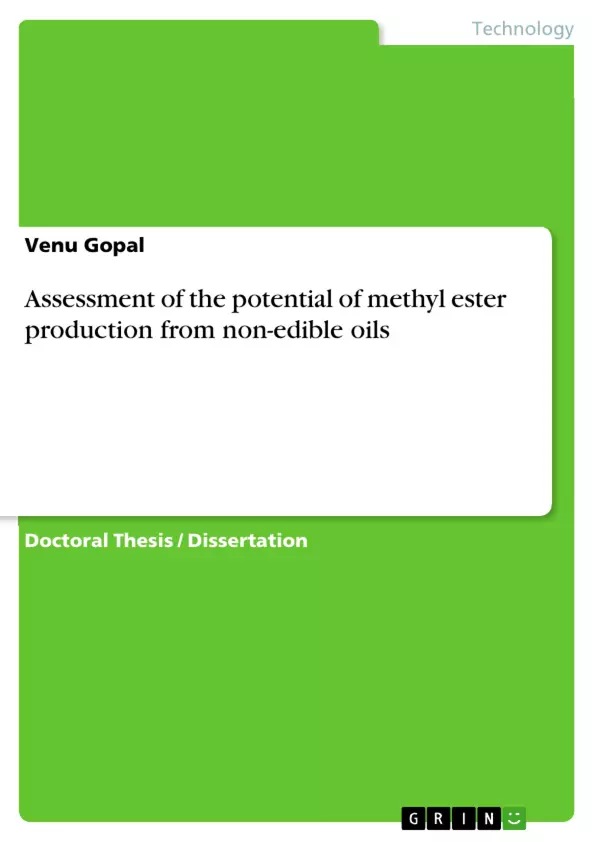Biodiesel as an alternative fuel for diesel engines is becoming increasingly important due to diminishing petroleum reserves and the environmental consequences of exhaust gases from petroleum-fueled engines. Biodiesel, which is made from renewable sources, consists of the simple alkyl esters of fatty acids. As a future prospective fuel, biodiesel has to compete economically with petroleum diesel fuels. A two-step transesterification process (Sequential esterification and transesterification process) was used to prepare methyl ester (biodiesel) from high free fatty acid (FFA) content oils. For the yield of high FFA, two-step acid-base catalyzed method has been developed which consists of acid-catalyzed pretreatment/esterification step to reduce the FFA to less than 1% using H2SO4 as an acid catalyst and transesterification of pretreated oil to biodiesel using alkali catalyst. In the present study, the main focus is being placed to explore the non-edible oil resources like Used Cooking Oil (UCO), Cottonseed oil, Jatropha (Jatropha curcas) oil, Neem(Azadirachta indica) oil as a potential source for biodiesel. Experimental results from enzyme (lipase) catalyzed method for selected oils using influencing parameters such as reaction time and catalyst weight, experimental results from acid-alkaline catalyzed methods using common influencing parameters such as methanol to oil molar ratio, catalyst weight, reaction temperature and reaction time for above-mentioned oils were compared using batch mode. Methyl ester (biodiesel) yield range of 66.20-71.6% was attained for an enzyme-catalyzed method, whereas for acid-alkaline the yield range was 84.4-91.6%. This gives the indication of further refinement in the enzyme-catalyzed transesterification process. However, enzyme-catalyzed biodiesel production has some limitations especially when implemented in industrial scale because of the high cost of enzyme, low reaction rate and enzyme deactivation. As the catalyst, an enzyme is restricted to rigorous reaction condition and the activity loss of lipase. The influencing parameters and absolute results of the analysis give the impression of the superiority of acid-alkaline transesterification method for methyl ester production. In this study, we have selected Used Cooking Oil Methyl Ester (UCOME) and Jatropha Methyl Ester (JME) among the methyl esters of four oils.
Inhaltsverzeichnis (Table of Contents)
- Introduction
- Literature Review
- Biodiesel Production
- Transesterification process
- Catalyst used in biodiesel production
- Non-edible oils for Biodiesel Production
- Experimental Methodology
- Materials and Methods
- Materials
- Methods
- Characterization of Feedstock and Biodiesel
- Physical and chemical properties of non-edible oils
- Physico-chemical properties of biodiesel
- Results and Discussion
- Influence of Feedstock on Biodiesel Production
- Transesterification process parameters on Methyl Ester Production
- Kinetics and modeling of Biodiesel Production
- Optimization of Transesterification Process
- Economic Analysis of Biodiesel Production
- Conclusions
Zielsetzung und Themenschwerpunkte (Objectives and Key Themes)
This thesis investigates the potential of producing methyl ester (biodiesel) from non-edible oils, aiming to provide a comprehensive assessment of its viability as a sustainable and alternative fuel source. The work focuses on optimizing the transesterification process, exploring various non-edible oil feedstocks, and analyzing the economic feasibility of biodiesel production.
- Assessment of the potential of biodiesel production from non-edible oils
- Optimization of transesterification process parameters for maximum biodiesel yield
- Evaluation of different non-edible oil feedstocks for biodiesel production
- Economic feasibility analysis of biodiesel production from non-edible oils
- Development of kinetic models for the transesterification reaction
Zusammenfassung der Kapitel (Chapter Summaries)
- Introduction: This chapter provides an overview of the global energy scenario, highlighting the importance of exploring alternative fuel sources like biodiesel. It discusses the potential of non-edible oils as feedstocks for biodiesel production and the advantages of using such resources.
- Literature Review: This chapter presents a comprehensive review of existing literature on biodiesel production, covering topics such as different transesterification methods, catalysts used, and various non-edible oils suitable for biodiesel production. It analyzes the advantages and disadvantages of each approach and identifies potential areas for further research.
- Experimental Methodology: This chapter details the materials and methods used in the research, including the selection and preparation of non-edible oils, the transesterification reaction process, and the characterization techniques employed to analyze the feedstock and biodiesel produced.
- Results and Discussion: This chapter presents the results obtained from the experimental studies, analyzing the influence of various factors such as feedstock type, catalyst concentration, reaction temperature, and time on biodiesel production. It discusses the optimization of the transesterification process, the kinetic modeling of the reaction, and the economic feasibility of biodiesel production.
Schlüsselwörter (Keywords)
This research explores the potential of methyl ester production from non-edible oils, focusing on the optimization of the transesterification process, evaluation of different feedstocks, economic feasibility analysis, and kinetic modeling of the reaction. The research utilizes various non-edible oils as feedstocks, explores different catalyst types and reaction conditions, and analyzes the physical and chemical properties of the produced biodiesel.
- Citation du texte
- Venu Gopal (Auteur), 2017, Assessment of the potential of methyl ester production from non-edible oils, Munich, GRIN Verlag, https://www.grin.com/document/432128



